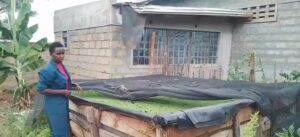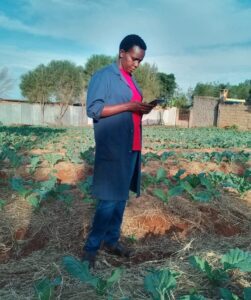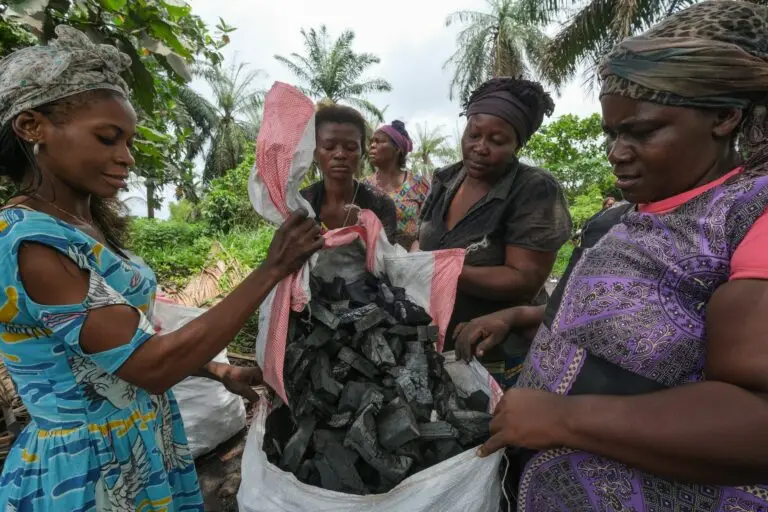Baringo is one of the counties in Kenya that has been affected by climate change. Being a semi-arid place, farmers must wrestle with tactical ways to survive and adapt to climate change. In Kabimoi village, Eldama Ravine Sub-county, a farmer, Bornes Korir, is innovating ways to sustain livelihoods through the practice of organic agriculture. The mixed farming involves a humble plant that plays a vital role within her farm. This is hazola, a plant that is grown in water. It does well in fish ponds, where its usage varies from helping farmers who are navigating the challenges of water scarcity, soil degradation, and climate change.
Hazola has emerged as a game changer, especially to farmers practicing agroecology, where nature and agriculture are intertwined. In the fish ponds, the plant absorbs nutrients from fish waste. It then helps maintain clean, oxygenated water for the fish while the fish feed on the same plant. Hazola is far from an ordinary plant. The water that is found under the plant has more nutrients and can be used to spray the crops, acting as manure.

“When harvested, the crop serves multiple purposes within the farm; it is used to feed poultry, rabbits, and even goats. It is a natural food that makes my chicken grow very healthy with a reasonable weight,” says Bornes. She added that initially, her animals required a lot of money to buy animal feed, but since she started planting hazola, the cost has reduced.
She considers hazola a miracle plant because it absorbs excess nutrients in the water, thus preventing algal blooms by supporting water freshness in the pond, leading to a reduction in diseases that normally attack fish.
On the other hand, Bornes rarely treats her chicken for diseases because the plant acts as an antivirus that protects her animals from disease attacks.
“In my farm, crops and animals depend on each other. It is a cycle of life where the pond feeds the crops; crops feed the animals, and animals feed back into the system,” she replied with a smile. This is a master class that involves more agroecology practices where nothing goes to waste. At the fish pond, the poultry droppings rich in nitrogen fertilize the water, enabling hazola to grow healthy while multiplying. When draining water from the fish pond, it is collected and used as a natural fertilizer for crops by spraying on them. This is the water that the fish, in turn, had provided with organic waste that fortifies the ponds.
At Bornes’ farm, vegetables of all types are seen flourishing and glowing. Spinach, kales, and other traditional vegetables are among the shining crops. The onions planted around the farm act as pest repellents to other vegetables. Ecosystem and productivity rule in this small farm where, at the hutch, rabbits are feeding on both harvested hazola plants and green vegetables. The goats are kept in a shaded goat house near the fish pond. “For the goats, I graze them on the grass that I harvest while weeding the farm, and add the hazola all in one place to form healthy animal feed,” Bornes said.

“I cover my fish pond with a shade net, which helps in protecting my pond by preventing foreign materials or animals from getting in,” she added. Inside her organic innovation, she maintains soil health by avoiding the use of chemicals on her farm. Instead, she prepares organic pesticide by mixing plants like chili, Sodom apple, mwarubaini, and garlic. She uses the leaves and mixes them in water to form a solution. The organic pesticide or insecticide safeguards crops during the process without harming pollinators and soil organisms. For fertilizer, she uses animal droppings collected and later sprays the crops with water from the fish pond. Remember, water in this case serves multiple purposes, from irrigation and foliar feeding to nutrient delivery. This has helped her curb the spread of soil and water degradation that has been witnessed in the entire Baringo.
This traditional knowledge, when combined with indigenous wisdom and the adoption of modern sustainable techniques, promotes climate change actions and solutions. As a result, it promotes food security by ensuring that even in a semi-arid area like Baringo, farming remains a viable and profitable practice.
The main challenge in Baringo is prolonged drought and rising temperatures. During such periods, Bornes has to employ tactical ways to ensure that the ecosystem around her remains healthy. She uses shade nets to reduce water evaporation by shielding her crops against excessive heat. To combat the larger part of the farm, she practices mulching and drip irrigation. “I spread materials like leaves and grass on the soil to retain moisture and keep the ground cool; the drip irrigation system ensures that all plants receive enough water directly to the roots without any wastage.” The water she uses for irrigation is water she harvested during the rainy season. She has set up a large tank that receives water through gutter channels from the house roof. This water can sustain dry months, ensuring that the farm remains productive, putting Bornes’ farm as a beacon of climate change adaptation.

What makes Bornes’ farm look more unique is the environment surrounding it, where she has planted food trees around her compound. Setting up a food forest in her compound has attracted and inspired other local farmers to visit the farm for benchmarking. They come to learn more about how such a farm keeps thriving under climate change pressure.
This practice of farming is one way of bonding with and appreciating nature by promoting a healthy ecosystem around humans. In return, nature is paying Bornes good money. This is through small vendors in Eldama Ravine who visit the farm to buy vegetables for reselling. She also exports hazola to farmers in other counties in Kenya who own fish ponds. From her chickens, she collects eggs that she sells at a nearby market. “I am managing all my bills starting from paying school fees for my children, paying the workers on the farm, fueling my car, and other basics from this farm. So, I can say it is a profitable practice since I usually take my family for a short vacation during holidays,” she says while smiling.
Agroecology is very cheap to start as it is more of organic farming. It means using the available resources at home without incurring any cost. For a food forest establishment, one can get seeds from home groceries. The journey of Bornes Korir is more than a personal triumph; she keeps learning every day through practice and observation on her farm. Her story drives hope and innovation, a testament to the community. The power of resilience in the face of climate change is also witnessed.
Even as she collects materials to prepare compost manure for her upcoming modern farm, it reminds us that we have no excuse for success. Her practice is one of the pathways that a country like Kenya, facing climate change, seeks. This is not just farming but climate-smart agriculture that not only promotes food security in Baringo but also restores the environment to its natural state through the food forest she has established. That means we can all align our farming with nature’s rhythm by cultivating not just crops but a sustainable future for generations to come



